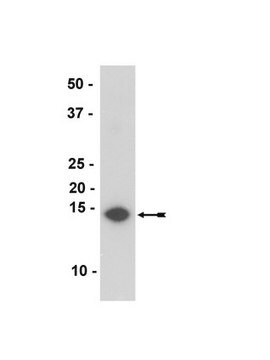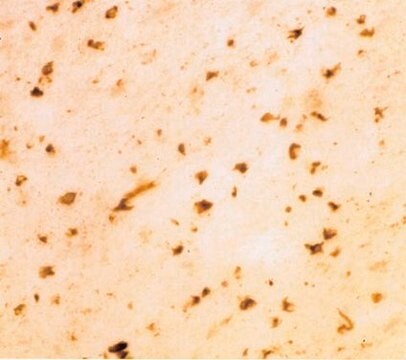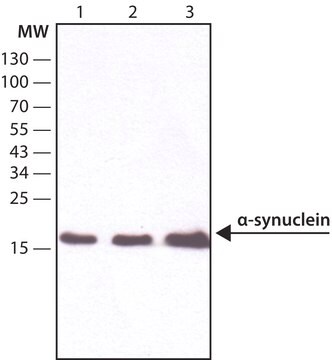MABN1817
Anti-α-Synuclein (SNCA) Antibody
mouse monoclonal, 2F12
Synonim(y):
Alpha-synuclein, NACP, Non-A beta component of AD amyloid, Non-A4 component of amyloid precursor, Synuclein alpha-140
About This Item
Polecane produkty
Nazwa produktu
Przeciwciało anty-α-synukleina, klon 2F12, clone 2F12, from mouse
pochodzenie biologiczne
mouse
Poziom jakości
forma przeciwciała
purified immunoglobulin
rodzaj przeciwciała
primary antibodies
klon
2F12, monoclonal
reaktywność gatunkowa
rat, human, mouse
metody
ELISA: suitable
immunocytochemistry: suitable
immunohistochemistry: suitable (paraffin)
immunoprecipitation (IP): suitable
western blot: suitable
izotyp
IgG2bκ
numer dostępu NCBI
numer dostępu UniProt
Warunki transportu
ambient
docelowa modyfikacja potranslacyjna
unmodified
informacje o genach
human ... SNCA(6622)
Opis ogólny
Specyficzność
Immunogen
Zastosowanie
Analiza ELISA: Reprezentatywna partia (0,4 µL w 30 µL buforu/basenik do powlekania) wychwyciła rekombinowaną ludzką α-synukleinę (0,2-40 ng/ml) w kanapkowym teście ELISA wykorzystującym klon SOY1 (nr kat. MABN1818; wstępnie sprzężony ze znacznikiem Sulfo) jako przeciwciało wykrywające (dzięki uprzejmości dr Tima Bartelsa, Brigham and Women's Hospital, Boston, MA, USA).
Analiza immunocytochemiczna: Rozcieńczenie 1:1000 z reprezentatywnej partii immunobarwionych pierwotnych mysich neuronów korowych (dzięki uprzejmości Tima Bartelsa, Ph.D., Brigham and Women's Hospital, Boston, MA, U.S.A.).
Analiza immunohistochemiczna: Rozcieńczenie 1:11 110 z reprezentatywnej partii immunobarwionych ciał Lewy'ego (LB) w skrawkach tkanki prążkowia z ludzkiego mózgu z chorobą Parkinsona (PD) (dzięki uprzejmości dr Tima Bartelsa, Brigham and Women's Hospital, Boston, MA, USA).
Analiza immunoprecypitacji: 4 µl z reprezentatywnej partii immunoprecypitowało α-synukleinę z 50 µg lizatu ludzkich komórek erytroleukemii HEL (dzięki uprzejmości dr Tima Bartelsa, Brigham and Women′s Hospital, Boston, MA, USA).
Analiza ELISA: Reprezentatywna partia wychwyciła zarówno endogenną α-synukleinę (αS) z ludzkiego homogenatu korowego, jak i egzogennie wyrażony typ dziki i rodzinne mutanty αS PD (fPD) (A30P, E46K, H50Q, G51D, A53T) z ekstraktów sytozolowych transfekowanych ludzkich komórek neuroblastoma M17D w aplikacji kanapkowej ELISA wykorzystującej klon SOY1 (Cat. Nr kat. MABN1818; wstępnie sprzężony ze znacznikiem Sulfo) jako przeciwciało wykrywające (Dettmer, U., et al. (2015). Nat. Commun. 6:7314).
Analiza ELISA: Reprezentatywna partia wychwyciła zarówno wstępnie zagregowaną fibrylarną rekombinowaną α-synukleinę, jak i częściowo oczyszczone ciałka Lewy'ego (LB) od pacjenta z DLB (otępienie z LB) z lub bez uprzedniej denaturacji próbki przez gotowanie z 2% SDS w aplikacji kanapkowej ELISA wykorzystującej klon SOY1 (nr kat. MABN1818; wstępnie sprzężony z tagiem Sulfo) jako przeciwciało wykrywające (Dettmer, U. i in. (2015). Nat. Commun. 6:7314).
Analiza immunocytochemiczna: Reprezentatywna partia wykryła cytozolową lokalizację endogennej szczurzej α-synukleiny (αS) i egzogennie nadeksprymowanej ludzkiej αS poprzez fluorescencyjne barwienie immunocytochemiczne 4% utrwalonych paraformaldehydem, 0,25% Triton X-100-permeabilizowanych pierwotnych neuronów szczura i transfekowanych ludzkich komórek neuroblastoma M17D (Dettmer, U., et al. (2015). Nat. Commun. 6:7314).
Analiza Western Blotting: Reprezentatywna partia wykryła monomeryczną α-synukleinę (αS), jak również multimery αS (αS60, αS80 i αS100) w ekstrakcie z usieciowanych glutaranem disukcynimidylu (DSG) mysich kawałków mózgu, ludzkich iPSC (zarówno mutanta S A53T, jak i skorygowanej linii izogenicznej) i ESC (zarówno typu dzikiego, jak i genetycznie zmodyfikowanej linii izogenicznej αS E46K). Znacząco obniżony poziom αS60 zaobserwowano u mutantów A53T i E46K (Dettmer, U., et al. (2015). Nat. Commun. 6:7314).
Analiza Western Blotting: Reprezentatywna partia wykryła monomeryczną α-synukleinę (αS), a także multimery αS (αS60, αS80 i αS100) w ekstraktach cytozolowych z usieciowanych glutaranem disukcynimidylu (DSG) pierwotnych neuronów szczura, a także ludzkiej białaczki erytroidalnej HEL i komórek neuroblastoma M17D (Dettmer, U., et al. (2013). J. Biol. Chem. 288(9):6371-6385).
Neuroscience
Jakość
Western Blotting Analysis: A 1:1,000 dilution of this antibody detected α-synuclein in 10 µg of human fetal brain tissue lysate.
Opis wartości docelowych
Postać fizyczna
Przechowywanie i stabilność
Inne uwagi
Oświadczenie o zrzeczeniu się odpowiedzialności
Nie możesz znaleźć właściwego produktu?
Wypróbuj nasz Narzędzie selektora produktów.
polecane
Kod klasy składowania
12 - Non Combustible Liquids
Klasa zagrożenia wodnego (WGK)
WGK 1
Temperatura zapłonu (°F)
Not applicable
Temperatura zapłonu (°C)
Not applicable
Certyfikaty analizy (CoA)
Poszukaj Certyfikaty analizy (CoA), wpisując numer partii/serii produktów. Numery serii i partii można znaleźć na etykiecie produktu po słowach „seria” lub „partia”.
Masz już ten produkt?
Dokumenty związane z niedawno zakupionymi produktami zostały zamieszczone w Bibliotece dokumentów.
Nasz zespół naukowców ma doświadczenie we wszystkich obszarach badań, w tym w naukach przyrodniczych, materiałoznawstwie, syntezie chemicznej, chromatografii, analityce i wielu innych dziedzinach.
Skontaktuj się z zespołem ds. pomocy technicznej








